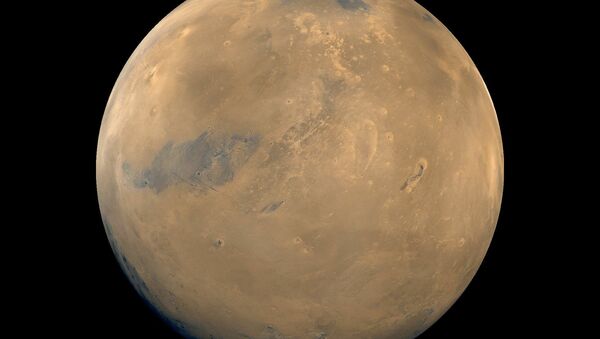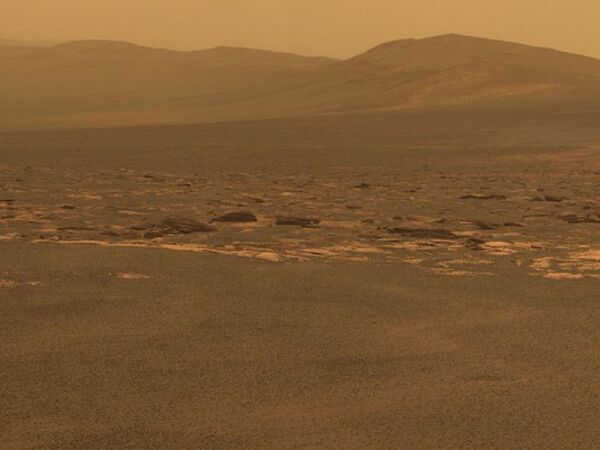A new study has confirmed that the planet Mars is wiggling while spinning on its axis. The research, ‘Detection of the Chandler Wobble of Mars From Orbiting Spacecraft’, published in the journal Geophysical Research Letters, states that a component of the motion of the Mars spin axis, dubbed the Chandler wobble, has been detected, for the first time for any solar system body other than the Earth.
As the Red Planet spins, its poles stray slightly away from its axis of rotation, moving about 4 inches (10 centimeters) approximately every 200 days.
The authors of the study used 18 years of data collected by three satellites orbiting the Red Planet: Mars Odyssey, Mars Reconnaissance Orbiter and Mars Global Surveyor, to detect the shift in the Martian poles.
#OnThisDay 7 April 2001 the 2001 #MarsOdyssey orbiter was launched
— Spyder Webb (@Spyder_Webb) April 7, 2018
Currently orbiting #Mars, its mission is to use #spectrometers & a thermal imager to detect evidence of past or present water/ice as well as study the planet's #geology & #radiation environment#space #astronomy pic.twitter.com/bJuD4mSgIS
This is the HiRISE Camera on NASA JPL’s Mars Reconnaissance Orbiter that takes those beautiful high resolution color pics of Mars with crystal clear detail pic.twitter.com/SU48vtmfyi
— Corby Waste (@MissionArtist) January 4, 2021
Mars seen globally in high definition by NASA's Mars Global Surveyor probe!
— Domenico (@AvatarDomy) April 13, 2019
Credit: NASA, JPL. pic.twitter.com/jFGlznNy95
Mars is the second planet in the universe to be known to exhibit the wiggling phenomenon that has been named the Chandler wobble, according to the American Geophysical Union's (AGU) news blog, Eos.org.
The effect, first discovered by astronomer Seth Carlo Chandler over a century ago, is manifested in planets that are not perfectly round.
#OnThisDay 1846: Astronomer Seth Carlo Chandler was born. He discovered the Chandler Wobble - a small deviation in the Earth's axis of rotation relative to the solid earth pic.twitter.com/yEYvaWky9E
— Imperial College (@imperialcollege) September 17, 2018
In the case of planet Earth, the wobble is more noticeable, with the poles straying about 30 feet (9 m) from the axis of rotation, in a circular pattern repeated about every 433 days.
Puzzling Wobble
While the effect the ‘wobble’ has on our planet Earth is negligible, according to Eos, scientists are still puzzled as to the mechanisms driving it. They originally calculated that the wriggle should ‘naturally die down’ within a century of its origin. However, Earth’s wobble has been continuing unabated.
The Earth spins around once every 24 hours on its axis, driving the continuous cycle of day and night. Meanwhile, forces cause the Earth to wobble as it spins, with scientists using lasers and mirrors to track the Earth's rotation.
Chandler Wobble: Why the Earth Wobbles Like a Toy Top https://t.co/43bu43ayRy pic.twitter.com/rFtlUX6xtL
— 🌎EarthHow (@earth_how) July 25, 2020
The wobble is fed to a degree by the pull of gravity from the sun and the moon, as well as variations in atmospheric pressure.
Ocean tide loading - the deformation of the Earth due to the weight of the ocean tides – as well as the wind, which changes the position of the Earth's axis relative to the surface, also feed into the effect.
July 25, 1976, Viking 1 orbiter takes (in)famous "Face on Mars" photo, feeding just last chapter of century old debate about "Martians" & #conspiracy theories. Mars Global Surveyor later showed that the face actually was a hill 🛰👽 pic.twitter.com/aAlRt0ni90
— History_of_Geology (@Geology_History) July 25, 2019
Yet another force determines the movement of the rotational axis over a period of a year. The Earth's elliptical orbit around the sun is the reason for this "annual wobble".
In the case of Mars, the authors of the research also believe the wobble will eventually die down.
As Mars has no oceans, with its surface rocky, with canyons, volcanoes, dry lake beds and craters all over it and red dust shrouding most of it, the wobbly rotation may be triggered by atmospheric pressure changes alone, according to Eos.
Scientists hope that further studies will offer more insight into the mysterious forces at play driving the persistent wonky movements.




